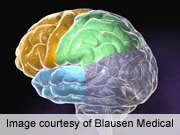Brain atrophy rather than cerebrovascular lesions may explain the relationship between type 2 diabetes mellitus and cognitive impairment, according to a study published online Aug. 12 in Diabetes Care.
(HealthDay)—Brain atrophy rather than cerebrovascular lesions may explain the relationship between type 2 diabetes mellitus (T2DM) and cognitive impairment, according to a study published online Aug. 12 in Diabetes Care.
Chris Moran, M.B., B.Ch., from Monash University in Melbourne, Australia, and colleagues analyzed magnetic resonance imaging scans and cognitive tests in 350 participants with T2DM and 363 participants without T2DM. In a blinded fashion, cerebrovascular lesions (infarcts, microbleeds, and white matter hyperintensity [WMH] volume) and atrophy (gray matter, white matter, and hippocampal volumes) were evaluated.
The researchers found that T2DM was associated with significantly more cerebral infarcts and significantly lower total gray, white, and hippocampal volumes, but not with microbleeds or WMH. Gray matter loss was distributed mainly in medial temporal, anterior cingulate, and medial frontal lobe locations in patients with T2DM, while white matter loss was distributed in frontal and temporal regions. Independent of age, sex, education, and vascular risk factors, T2DM was associated with significantly poorer visuospatial construction, planning, visual memory, and speed. When adjusting for hippocampal and total gray volumes, the strength of these associations was cut by almost one-half, but was unchanged with adjustments for cerebrovascular lesions or white matter volume.
"Cortical atrophy in T2DM resembles patterns seen in preclinical Alzheimer's disease," the authors write. "Neurodegeneration rather than cerebrovascular lesions may play a key role in T2DM-related cognitive impairment."
One author disclosed financial ties to the pharmaceutical industry.
More information:
Abstract
Full Text (subscription or payment may be required)
Journal information: Diabetes Care
Copyright © 2013 HealthDay. All rights reserved.






















